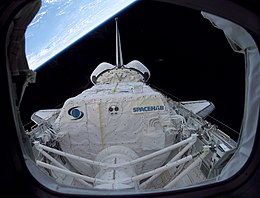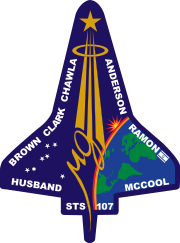 Spacehab's Research Double Module in Columbia's payload bay during STS-107 | |
| Names | Space Transportation System-107 |
|---|---|
| Mission type | Microgravity research |
| Operator | NASA |
| COSPAR ID | 2003-003A |
| SATCAT no. | 27647 |
| Mission duration | 15 days, 22 hours, 20 minutes, 32 seconds |
| Distance travelled | 6,600,000 miles (10,600,000 km) |
| Orbits completed | 255 |
| Spacecraft properties | |
| Spacecraft | Space Shuttle Columbia |
| Launch mass | 263,706 pounds (119,615 kg) |
| Landing mass | 232,793 pounds (105,593 kg) (expected) |
| Payload mass | 32,084 pounds (14,553 kg) |
| Crew | |
| Crew size | 7 |
| Members | |
| Start of mission | |
| Launch date | January 16, 2003 15:39:00 UTC |
| Launch site | Kennedy, LC-39A |
| End of mission | |
| Decay date | February 1, 2003, 13:59:32 UTC Disintegrated during reentry |
| Landing site | Kennedy, SLF Runway 33 (planned) |
| Orbital parameters | |
| Reference system | Geocentric |
| Regime | Low Earth |
| Perigee altitude | 170 miles (270 km) |
| Apogee altitude | 177 miles (285 km) |
| Inclination | 39.0 degrees |
| Period | 90.1 minutes |
 STS-107 mission patch  Rear (L-R): David Brown, Laurel Clark, Michael Anderson, Ilan Ramon; Front (L-R): Rick Husband, Kalpana Chawla, William McCool | |
STS-107 was the 113th flight of the Space Shuttle program, and the 28th and final flight of Space Shuttle Columbia. The mission ended on February 1, 2003, with the Space Shuttle Columbia disaster which killed all seven crew members and destroyed the space shuttle. It was the 88th post-Challenger disaster mission.
The flight launched from Kennedy Space Center in Florida on January 16, 2003. It spent 15 days, 22 hours, 20 minutes, 32 seconds in orbit. The crew conducted a multitude of international scientific experiments.[1] The disaster occurred during reentry while the orbiter was over Texas.
Immediately after the disaster, NASA convened the Columbia Accident Investigation Board to determine the cause of the disintegration. The source of the failure was determined to have been caused by a piece of foam that broke off during launch and damaged the thermal protection system (reinforced carbon-carbon panels and thermal protection tiles) on the leading edge of the orbiter's left wing. During re-entry the damaged wing slowly overheated and came apart, eventually leading to loss of control and disintegration of the vehicle. The cockpit window frame is now exhibited in a memorial inside the Space Shuttle Atlantis Pavilion at the Kennedy Space Center.
The damage to the thermal protection system on the wing was similar to that of Atlantis which had also sustained damage in 1988 during STS-27, the second mission after the Space Shuttle Challenger disaster. However, the damage on STS-27 occurred at a spot that had more robust metal (a thin steel plate near the landing gear), and that mission survived the re-entry.
- ^ "HSF - STS-107 Science". NASA. May 30, 2003. Archived from the original on September 3, 2012. Retrieved September 2, 2012.